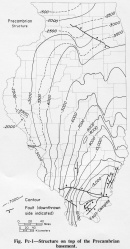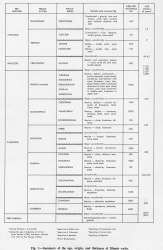Precambrian Erathem
Chronostratigraphy: Precambrian Erathem
Primary source
Willman, H. B., Elwood Atherton, T. C. Buschbach, Charles Collinson, John C. Frye, M. E. Hopkins, Jerry A. Lineback, and Jack A. Simon, 1975, Handbook of Illinois Stratigraphy: Illinois State Geological Survey Bulletin 95, 261 p.
Contributing author(s)
Elwood Atherton
Name
Original description
Derivation
Other names
History/background
Type section
Type location
Type author(s)
Type status
Reference section
Reference location
Reference author(s)
Reference status
Stratigraphic relationships
The Precambrian rocks, which are commonly referred to as the basement, lie at depths ranging from about 2000 feet below the surface in the northernmost part of Illinois to about 14,000 feet below the surface in the deepest part of the Illinois Basin in southern Illinois (fig. Pc-1). Only 20 borings have penetrated and sampled the Precambrian basement in Illinois.
Extent and thickness
Illinois is part of the Precambrian granite-rhyolite terrane, relatively uniform in rock type and age, that extends from the Mississippi River eastward into Ohio (Rudman et al., 1965). Aeromagnetic maps of Illinois show a strong, anomalous magnetic gradient band parallel to and along the Rough Creek Fault Lineament in southern Illinois, indicating that this may be a zone of significant intrusive activity. The anomaly pattern shows an over-all homogeneity north of the lineament, suggesting a rough uniformity in composition of the deep rocks in that area. The gravity map of Illinois shows regionally denser crust south of this lineament (Heigold, in preparation).
The buried surface of the Precambrian, where it can be adequately studied, is hilly (Atherton, 1971). In Pike County in western Illinois, two deep tests 8 miles apart reveal a relief of about 800 feet on the Precambrian surface. Several tests found the basal Cambrian Mt. Simon Sandstone unexpectedly thin or absent over the Precambrian. Presumably, these wells encountered Precambrian hills too high to have been covered by the regional blanket of Mt. Simon Sandstone. Too few Precambrian tests have been drilled in the deep part of the Illinois Basin to indicate the local relief, but, if information from adjacent states is a reliable indication, the relief may be several hundred feet. Wells that pass through the Mt. Simon normally enter fresh-looking igneous rock. The feldspar grains in the arkose forming the base of the Mt. Simon and in the underlying granitic rock also have a fresh appearance. Any weathered material that may once have accumulated was evidently eroded before deposition of the Paleozoic sediments.
Lithology
The Precambrian rocks from the 20 borings in Illinois have included 10 red granites, 4 pink granites, one gray granite, 4 granodiorites (two of which occur in the same wells as granites), one felsite (in the same well as granite), one rhyolite, one red granophyre, and one red-brown granite porphyry (Grogan, 1949; Bradbury and Atherton, 1965). All but one of the granites contain potash feldspar and quartz as the chief constituents, various amounts of plagioclase, and biotite as the chief dark mineral. The other granite, from Will County, is alkalic and contains riebeckite rather than biotite. Apatite and zircon are present in all the granites, and sphene, fluorite, epidote, and allanite occur in many. The granites are medium to coarse grained, and most appear to be somewhat porphyritic.
The granodiorites are similar to the granites but contain greater amounts of ferromagnesian minerals. The rhyolite is porphyritic, with phenocrysts of quartz and red feldspar in an aphanitic groundmass. The granophyre in composition falls between the compositions of the granite and the rhyolite; it contains an abundance of micropegmatite. No mafic igneous rocks or metasediments have been encountered in the basement of Illinois, but reports of these rock types in the Precambrian of adjacent states suggest that they may be present.
Core(s)
Photograph(s)
Contacts
Well log characteristics
Fossils
Age and correlation
Age determinations for the uppermost Precambrian rocks in Illinois range, with one exception, from about 1100 to 1400 million years (m.y.) (Lidiak et al., 1966) and fall within the Precambrian Y time unit designated by the United States Geological Survey (James, 1972). The exception was the determination made on granite samples from one well in La Salle County, which gave the anomalously low age of only 640 m.y. If correct, that date suggests that younger Precambrian rocks may be present in local areas. Because Cambrian deposition in Illinois probably began 525 million years ago in Croixan (late Cambrian) time (fig. 1), the unconformity on the Precambrian rocks represents an interval of 600 to 900 m.y.
Environments of deposition
Economic importance
Remarks
References
ATHERTON, ELWOOD, 1971, Tectonic development of the Eastern Interior Region of the United States: Illinois State Geological Survey Illinois Petroleum 96, p. 29-43.
BRADBURY, J. C., and ELWOOD ATHERTON, 1965, Precambrian basement of Illinois: Illinois State Geological Survey Circular 382, 13 p.
GROGAN, R. M., 1949, Present state of knowledge regarding the Pre-Cambrian crystallines of Illinois: Illinois Academy of Science Transactions, v. 42, p. 97-102; 1950, Illinois State Geological Survey Circular 157.
HEIGOLD, P. C., in preparation, An aeromagnetic survey of southwestern Illinois: Illinois State Geological Survey Circular.
JAMES, H. L., 1972, Stratigraphic Commission Note 40-Subdivision of Precambrian: American Association of Petroleum Geologists Bulletin, v. 56, p. 1128-1133.
LIDIAK, E. G., R. F. MARVIN, H. N. THOMAS, and M. N. BASS, 1966, Geochronology of the Midcontinent region, Part 4, Eastern area: Journal of Geophysical Research, v. 71, p. 5427-5438.
RUDMAN, A. J., C. H. SUMMERSON, and, W. J. HINZE, 1965, Geology of basement in midwestern United States: American Association of Petroleum Geologists Bulletin, v. 49, p. 894-904.
ISGS Codes
| Stratigraphic Code | Geo Unit Designation |
|---|---|

